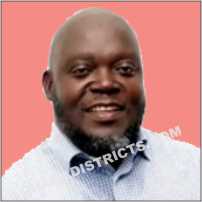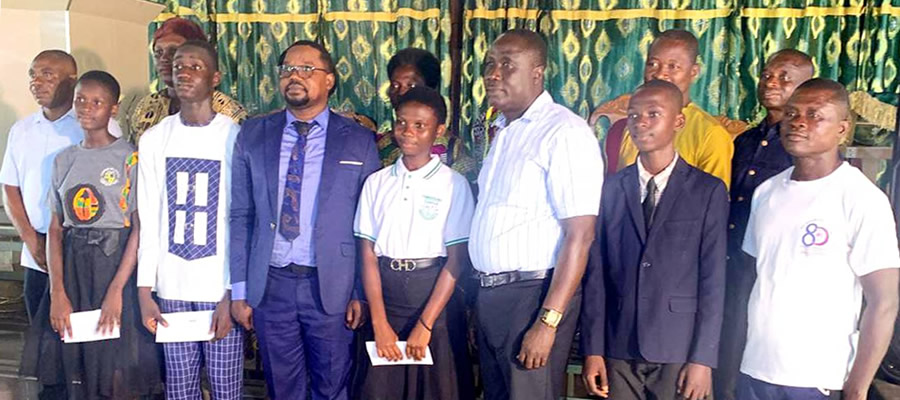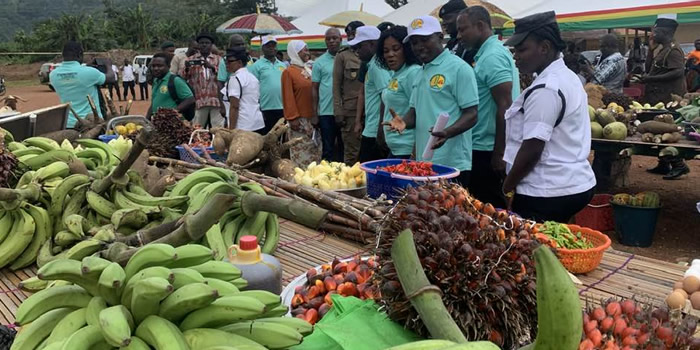

Education
The important role that education plays in the social, cultural and economic development of a country as a whole and the District in particular cannot be over-emphasized. In a developing peri-urban District like Obuasi East, the need for skilled manpower is important. The development of the district is largely depended on the quality of education. In Obuasi East, there are numerous efforts to ensure quality and adequacy of educational infrastructure. The situation of Educational infrastructure within the district needs major improvement.
Number of Schools and Ownership (School Enrolment)
The Education Sub-Sector is one of the major building blocks to the development of human resource for accelerated growth. The government’s educational reform policies seek to address issues pertaining to access to different levels of educational ladder. With respect to this, Obuasi East District has its levels of educational ladder to the Senior High School level. From the District Directorate of Education, there are a total number of 187 schools both privately and publicly owned in the District. Out of this number, 70 are pre-schools (KG), 76 are primary schools, 37 Junior High Schools and 4 Senior High Schools. This is woefully inadequate considering the growing population of the district.
Distribution of the schools into quantity and ownership is showed in the table below.
Table 1.34: School Enrolment rate in Obuasi East District
Source: District Directorate of Education -OEDA Sept. 2018.
From Table 1.34, it could be deduced that the total number of public schools in the District is 63 and that of the private is 124. This clearly shows that the private sector contributes more than the public sector as far as the provision of educational infrastructure in the District is concern.
The public sector on the other hand, is lagging behind with about 32.62% educational infrastructure as compared to the private. This implies that more public schools are expected to be built for the levels or categories of the educational ladder in the district especially in communities that lack these infrastructures to bridge the gap between the private and the public schools.
There are 52 school blocks in the private sector at the pre-school level (KG) and primary level. It however reduces as the level of education increases. This can be attributed to the fact that as the level increases, the necessary facilities needed for the establishment of them are many and expensive discouraging people from investing.
In addition to the above, a greater proportion of the people (48.03%) in the district patronize public educational institution. This can be attributed to a number of factors. These include the capitation grant and school feeding programme introduced by the government as a way of helping build or improve the human resource of the nation which has really influenced the patronage of public education institutions at the basic levels.
Fig. 9 Map showing Junior High Schools
Schools by Religious Denominations
Table 1.35 indicates that the private schools’ dominant in the delivery of educational infrastructure in the district representing 66.31%. The involvement of religious bodies in providing the educational needs of the people in the district cannot be overemphasized. Out of the 18 public pre-schools (nursery/kindergarten), only 5 are owned and managed by the various religious bodies.
Also, out of the 27 primary schools owned by the government, 5 belong to the various religious bodies. Of the 17 public JHS, 5 were established by religious denominations. More participation of the religious bodies in educational provision is similarly needed and must be encouraged through the offer of incentives such as easy access to land for construction of these infrastructures for the community and the district at large. The Methodist churches have the highest number of schools in the district. This is followed by the catholic churches with Islamic and Anglican having the least number of schools.
The Table below shows the number of schools by Religious Denominations as at 2018.
Table 1.35: Schools by Religious Denominations as at 2018
Source: District Directorate of Education-OEDA Sept. 2018.
Table 1.36: Trend in Overall Enrolment 2014-2017 for both Public and Private Schools
Source: District Directorate of Education-OEDA Sept. 2018.
From Table 1.36, total enrolment decreased from 59,433 (for both primary, JHS and SHS) in 2014/2015 to 53,428 in the 2015/2016 academic year. Similarly, the enrolment again decreased to 50,952 in 2016/2017 academic year. The trend of overall enrolment keeps on decreasing from 2013/2014 academic year to 2016/2017. This could be attributed to the fact that the district is a mining town and the child could be engaged in the galamsey activities and other forms of child labour. The decreasing in school enrolment requires that government to put in pragmatic measures and policies to meet the ever decreasing enrolment rate.
Girl Child Education in the District
Girl Child Education is of greatest importance in the district and the nation at large. Education of the gender had been skewed towards the boy child as most parents preferred sending their male child to school at the expense of the girl child. Improving girl child education has been one of the top priorities in the Medium Term Development Plan of the District.
To this effect, provision is made for training of officers from the District Directorate of Education and teachers to embark on a comprehensive programme to encourage more girls into the classroom. According to the District Directorate of Education the following are efforts/activities the Education Service is undertaking to promote Girl Child Education in Obuasi East District.
- Training of community-based girls’ education facilitators to peer-educate other girls on the need for education.
- Community based education programmes to sensitize parents on the importance of girlchild education.
- Regular visitation to schools to sensitize pupils on the importance of Gild Child Education
- Monitoring of girls’ club activities and training of School Based Girl Child Co-ordinator (SBGCC)
- Programmes to get teen mothers back to school.
- To organise girls’ education week to sensitize the communities to help stop the adolescents from early sex and its negative consequences.
The District Assembly needs to give much attention to girl child education. The implications of large number of uneducated girls are more births, large family sizes and its associated demand on social amenities hence increasing the dependency ratio in the district.
Public Educational Infrastructure
Obuasi East District is confronted with numerous developmental challenges. One of such challenges is the poor state of educational infrastructure in the District. The classrooms block in the Districts are inadequate and the few that exist in the district are also in a deplorable condition. Records available at the District Directorate of Education indicate that two (2) of primary school buildings and one (1) of JHS block are in dilapidated state and calls for total replacement.
The District Assembly is expected to double its efforts in improving the quality of classroom infrastructure in the District.
Conditions of Public Educational Infrastructure and Facilities
The physical state of most of the school buildings especially the primary and JHS is of great concern to the District Assembly. While some do not have enough structures, those that are available are also in a dilapidated state. Most of the schools also do not have toilet facilities and clean drinking water. These problems affect quality teaching and learning in most of the schools in the district.
Table 1.37: Conditions of Public Educational Infrastructure in the District
Source: District Directorate of Education-OEDA Sept. 2018.
Out of the twenty-seven (27) primary schools, eleven (11) are without toilet and water facilities. Sanitation in schools in the district leaves much to be desired. It is not surprising that bushes around schools are littered with faecal matter. The health implications of this on the teachers, pupils and those who live around the schools are serious. There is therefore, the urgent need for the District Assembly to provide these schools with the needed facilities to help minimise indiscriminate disposal of faecal matter. In addition to the above, schools without water provisions should be catered for to help solve the problem of access to water in schools.
Teacher Qualification
The table below shows the proportion of Trained and Untrained teachers in the district.
Table 1.38: Trained and Untrained Teachers in Obuasi East District as at 2018
Source: District Directorate of Education-OEDA Sept. 2018.
It is obvious from the table 1:38 that trained teachers out number their untrained counterparts. Data gathered on the table above revealed that the district has a total number of 1,421 teachers in both public and private schools, out of which 729 are trained representing 51.30% and 692 are untrained representing 48.70%. With regards to public schools, the district has a total number of 612 teachers, out of which 93.30% are trained and 6.7% are untrained. The private schools have a total number of 809 teachers out of which 19.53% are trained and 80.47% are untrained. This shows that there are adequate teachers in the district and the issue has to do with the contextual distribution of trained teachers in both public and private schools since greater percentage of trained teachers are found in public schools.
It is also obvious from the analysis that whereas the public schools have 93.30% of trained teachers the private schools have only 6.7% trained teachers. The number of untrained teachers is significantly higher at the Private schools. Untrained teachers should be encouraged for further studies or distance learning programmes in education and regular in- service-training to enable them acquire the professional skills in teaching. This could also be in the form of intensive training workshop to abreast these untrained teachers with the vital professional and pedagogical skills required to promote quality teaching and effective learning. Another way to attract more trained teachers into the district is for the District Assembly in collaboration with the District Directorate of Education to provide decent accommodation for the teachers.
Teacher-Pupil Ratio
The Teacher-Pupil Ratio gives an indication of the number of pupils that are supposed to be handled by one teacher in the district. The Teacher-Pupil Ratio is an indicator that shows the number of pupils that are supposed to be handled by one teacher. The Teacher-Pupil Ratio in the district is represented in the table below. The table indicates that there would be no pressure on teachers since the number of pupils to teacher across all the levels is below the regional and national standard. There is the need to put in place motivational mechanisms to get the best teachers to improve teaching and learning to reflect on performance in all levels.
Table 1.39: Teacher- Pupil Ratio at various Categories
Source: District Directorate of Education-OEDA Sept. 2018.
The table above suggest that, the Teacher-Pupil Ratio (TPR) in Obuasi East District is low at the KG level as compared to the regional and national ratios. The pre-school level (KG) showed a pupil-teacher ratio of 1:14 which is lower than the national figure of 1:50. Also, the primary, JHS and the SHS Pupil Teacher Ratio is far lower than the regional and national.
The implication for high teacher pupil ratio is that, teaching and learning activities would be tedious and ineffective since the teachers would be over-burdened. A low pupil teacher ratio is a potential for improving the quality of education since there will be sufficient teachers for the classes. This will help facilitate teacher interactions with students and also attend to the special needs of every individual student. The KG, primary, JHS and the SHS teacher pupil ratio condition is more favourable and should be maintained or improved upon.
Classroom Pupil Ratio in Public Schools
Efforts in provision of classroom for all the educational level over the years has reduce pressure on the classroom demand in the district. Pupils to classroom ratio are below the standard at all levels of education. This implies that, there are inadequate classroom blocks in the district. This calls for the provision of additional classroom block and the renovation of existing ones to enhance effective teaching and learning at all levels of education.
The table below shows the classroom to pupil ratio in the district.
Table 1.40: Classroom Pupil Ratio in Public Schools
Source: District Directorate of Education-OEDA Sept. 2018.
Gross Enrolment Rate (GER)
Table 1.41: Gross Enrolment rate in the district
Source: District Directorate of Education-OEDA Sept. 2018.
Table 1.41 shows the Gross Enrolment rate in the district. There seems to be higher Gross Enrolment Rate (GER) for Primary Male students in the district.
Net Admission Rate (NAR) in Primary Schools
Table 1.42: Net Admission Rate (NAR) in Primary Schools
Source: District Directorate of Education-OEDA Sept. 2018.
Gender Parity Index (GRI) in Public Schools
Table 1.43: Gender Parity Index (GRI) in Public Schools
Source: District Directorate of Education-OEDA Sept. 2018.
School Performance at Basic Education Certificate Examination (BECE) Level
An observation of BECE results in the District may reveal a beautiful picture in terms of school participation rate which is over 98%. However, a critical analysis of the picture indicates that schools that are closer to peri- urban communities have the tendency of contributing to the high performance. On the other hand, the performances of public schools in remote communities usually obtain low pass rate mainly due to negligence in supervision, inadequate logistics and poor teaching and learning materials.
The Table below shows the performance of BECE Exams in the district for the past four (4) years.
Table 1.44: Pupils’ Performance at the BECE Level from 2014-2017
Source: District Directorate of Education-OEDA Sept. 2018.
Out of a total number of 6,299 candidates that was presented for the 2014 BECE, the public and the private schools recorded 43.70% and 53.20% respectively. In terms of gender, the number of girls presented for BECE from 2014-2017 are more done the boys for both public and private schools. There is therefore the need the continue with intensive girl child education to encourage parents to support female child in education.
In 2016 Basic Education Certificate Examination (BECE), the public school recorded 45.2% as against 51.8% of the private schools. This is a sign of good performance for both the public and private schools in Obuasi East District. Furthermore, the performance of private schools for the BECE results in the past years outweigh that of the public schools These are levels that students should receive proper foundation in education so that they can build upon at a later date.
In the face of this, the following have been recommended to ensure further improvement in the BECE performance and education in the Obuasi East District;
- Provision of adequate educational infrastructure
- Regular and effective supervision of teachers
- Posting of trained teachers
- Supply of Textbooks and other teaching and learning materials
- Motivation to hardworking teachers and supervisors
- Provision of awards to pupils who perform exceptionally well
Challenges facing the Educational Sector in the district
After in-depth analysis with the educational sector in the district, the following challenges emerged.
1. Inadequate office for the Directorate of Education.
2. Inadequate furniture, teaching and learning materials at all levels of education in the district.
3. Inadequate funds to undertake educational activities
The way forward for the Educational Sector
1. Additional Classroom Blocks needed to curtail the problem of Pupil-Classroom-Ratio in the district.
2. The Directorate of Education needs additional office to improve efficiency in education.
3. Provision of adequate dual desk and teaching and learning materials at all levels of education in the district.
Date Created : 6/2/2023 12:00:00 AM












 facebook
facebook
 twitter
twitter
 Youtube
Youtube
 +233 593 831 280
+233 593 831 280 0800 430 430
0800 430 430 GPS: GE-231-4383
GPS: GE-231-4383 info@ghanadistricts.com
info@ghanadistricts.com Box GP1044, Accra, Ghana
Box GP1044, Accra, Ghana